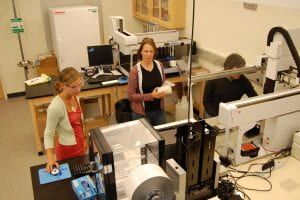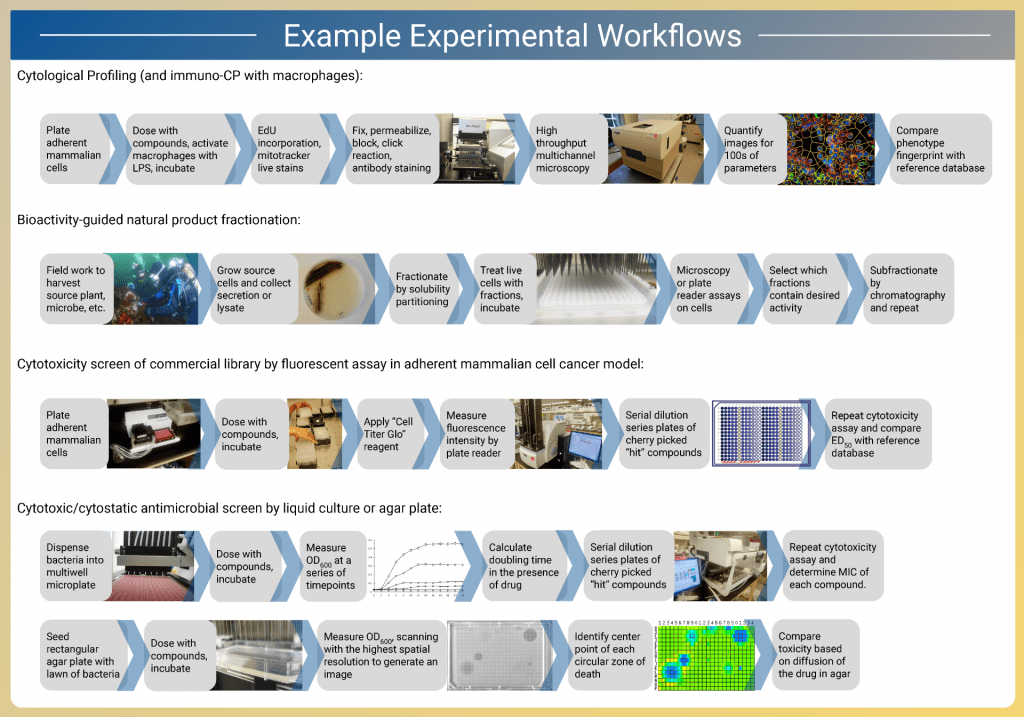 What we do:
What we do:
We are primarily a self-service facility that trained users can access. Reserved instrument and staff time is paid for by the principal investigators’ research funds, and this in turn funds the maintenance of the facility as a financially independent, self-sustaining unit.
The CSC has 5 thoughtful intentions behind this choice to be self-service.
- The university's primary mission is education – and for science, the classroom is not the only (or the best) place to accomplish this. We teach hands-on science to students of all experience levels, allowing them to participate in the discovery process first hand. Send us your lab member and we will shape them into a screening specialist! We find that students are excited about our cool technologies and enthusiastic to learn new skills.
- Since we house the same kinds of equipment and drug libraries that one would find at a pharmaceutical company's R&D department, we are well-placed to offer trainees attractive skills for their resumes that improve their job search prospects, and will be better prepared for tasks in new positions that overlap with these skills.
- Our professional lab setting exposes trainees to scientific rigor, reproducibility, and lab safety culture that extends beyond our own lab. It isn't easy to measure this contribution, but each bit helps to ensure the future of science as a human endeavor.
- As a land grant university, UCSC has a commitment to make a difference within our community. Local biotech and pharma recruiters benefit from a well-trained applicant pool of UCSC graduates who have been exposed to chemical screening operations.
- If researchers want to outsource work and not be involved in the scientific process, then they can choose between us and other competing off-site businesses where customers mail their samples for standard analyses. Since we are a small operation, the area where we can outperform these competitors and offer something unique is in custom assay development with trainees involved hands-on.
The university has its own reasoning behind its institution-wide model of having the core facilities be separate business units. Advantages from our perspective include:
- One person (the CSC Director of Operations) is intimately aware of all aspects of running the facility, down to the tiniest detail.
- The CSC budget, for keeping the facility staffed and equipped, is very tightly monitored by CSC staff, with no waste.
Upon request, our staff can consult on:
- project design
- protocol development
- training
- data analysis
- contributing ideas and language to proposals
- writing up your screen methods/results for publication or a thesis, etc.
We can run assays side-by-side with you as a team at the bench – to help teach a trainee a standard operating procedure, to have experts on hand to guide inexperienced users, or as an extra set of hands for large screes. A lot of users find the team approach more fun, less stressful, and more likely to be successful the first time!
This is mutually beneficial because our involvement on a collaborative project lets us provide continuation of the detailed procedures involved, which is valuable when a user has left UCSC and a new lab member wants to pick up the project without reinventing the wheel.
In specific cases, the CSC staff can run experiments for customers, start to finish. Please inquire about proposed experiments' timelines and cost estimates (to be billed per project instead of per instrument and staff time used). We will meet with you to determine the scope of the work planned.
For more information on our equipment and associated protocols and instructions, please see the Equipment & Resources page and navigate to the instrument you want the protocol for (e.g. plate reader or imager). Here is a very summarized, partial list:
- Cell Titer Glo cytotoxicity screens in mammalian cells
- Absorbance-based microbial growth screens
- Cell cycle profiling by imaging (includes EdU incorporation and other markers)
- Cytological Profiling of HeLa cells
- immune-Cytological Profiling of RAW264.7 cells
Coming soon: protocols being migrated to protocols.io! If you have a UCSC CruzID, you can get a free Premium account on the institutional plan. Get your own account at https://www.protocols.io/institutions/ucsc. If you are interested in editing a CSC protocol, you have 3 options:
- Make it your own by creating a "fork." It will retain the metadata and be linked to the original protocol, but the new fork will be your own, in your private workspace, not visible to anyone (unless you then share your protocol). This is useful if you have your own adaptation specific to your own project/lab that other CSC users aren't necessarily interested in, and you want it separated from the CSC.
- Make a collaborative "version" of the protocol that will be connected to the original version, shared with the same people. Attempting to make a version triggers the CSC to approve the request. This allows users to build on the basic protocol made by the CSC, adding details, tips, pictures, videos, etc. that all users can then benefit from.
- Become a member of the UCSC CSC workspace. You will be able to see all the protocols we have and make changes to them. Please contact CSC staff if you want to go this route, and we'll determine

Suggested acknowledgement language:
- “Technical support was provided by (insert personnel name here), UCSC Chemical Screening Center RRID SCR_021114.”
- “Purchase of the (insert equipment name here) used in this research was made possible through the National Institutes of Health Grant (insert grant number here), awarded to the UCSC Chemical Screening Center RRID SCR_021114.”
- Grant numbers to reference for equipment purchases are:
| 1S10RR022455-01A1 | “old” equipment purchased in ~2007 (pinning robot, cherry picking robot, EnVision plate reader, ImageXpress microscope, ELx405 plate washers…) |
| 1S10OD028730-01A1 | “new” equipment purchased in ~2021 (Echo, Explorer, Flex robots, Phenix, BioTek EL406, second EnVision with HTRF and alpha, Signals Image Artist and Spotfire bioinformatics…) |
We ask that you please:
- mention us in your manuscripts, presentations, and any media, if any of our resources were used in the project being described.
- mentions should ideally be in two places, as appropriate: (1) in the methods section alongside the appropriate step where the resources were used (usually include instrument and facility name with RRID, plus cite the DOI of any protocols used and/or reference relevant CSC publications) AND (2) in the acknowledgements section (usually acknowledge the staff people who assisted and/or grants that funded the instrumentation).
- use our RRID SCR_021114 to enable tracking of mentions. Click here to learn about RRIDs.
- alert the CSC leadership so that the publication can be recorded and used in our work. If you are not sure if we saw your paper, then you can check our publications list on our website.
Publications as proof of our productivity are essential to ensuring the continuation and expansion of our resources.
- Any peer-reviewed publication that acknowledges the CSC supports our NIH instrumentation grants and other applications for funds, including in-house to our Office of Research.
- Acknowledgements of our personnel supports their professional development.
- Tracking the impact of our resources can help guide decisions on what resources to continue or expand.
- Acknowledgements, including in your talks and posters on and off campus, help recruit new users who may not have been aware of the resources to be found here.
- Mentions with our RRID automatically get picked up and added to our mention counter on SciCrunch and Core Marketplace, where this count helps give us credibility to attract external users.
If you feel that the CSC personnel have had an intellectual contribution to your project, we humbly ask you to consider “middle” authorship where appropriate. Some general guidelines on authorship (written by the Royal Microscopic Society) are available here.
If you feel that the CSC personnel have had an intellectual contribution to your project, we humbly ask you to consider "middle" authorship where appropriate.
Some general guidelines on authorship:
- An infographic by the Royal Microscopic Society here
- Written by the International Committee of Medical Journal Editors here
Often, journals let you outline which authors made which contributions. These can be tracked if you use the official contributor roles, as set by the National Information Standards Organization (NISO). The roles and descriptions can be found at the official page of CRediT, a branch of NISO and described by PLoS in a summary table. Some authorship-worthy roles (and their official definitions) most likely to have overlapped with the CSC activities could include:
- Resources – Provision of study materials, reagents, materials, patients, laboratory samples, animals, instrumentation, computing resources, or other analysis tools.
- Methodology – Development or design of methodology; creation of models.
- Investigation – Conducting a research and investigation process, specifically performing the experiments, or data/evidence collection.
- Data curation – Management activities to annotate (produce metadata), scrub data and maintain research data (including software code, where it is necessary for interpreting the data itself) for initial use and later reuse.
- Formal analysis – Application of statistical, mathematical, computational, or other formal techniques to analyze or synthesize study data.
- Validation – Verification, whether as a part of the activity or separate, of the overall replication/reproducibility of results/experiments and other research outputs.
- Visualization – Preparation, creation and/or presentation of the published work, specifically visualization/data presentation.
- Review & editing (of writing) – Preparation, creation and/or presentation of the published work by those from the original research group, specifically critical review, commentary or revision – including pre- or post-publication stages.
- Project administration – Management and coordination responsibility for the research activity planning and execution.
- Supervision – Oversight and leadership responsibility for the research activity planning and execution, including mentorship external to the core team.
Getting started:
If you are interested in working with us, you can contact us to discuss, review our prices, explore what equipment we have available, see who we have on staff, and read our publications. Our training curriculum is tracked via a Google form. It can also be printed here. Please also check out the new training videos.
This page was last updated on 20230317.
